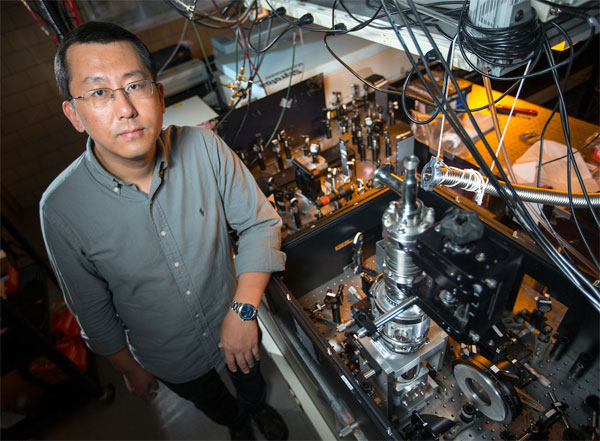Researchers have used ultrafast photonics to visualize electrons interacting as a hidden state of matter in a superconductive alloy. When fully understood and tuned, this state of matter could be used for faster, heat-free quantum computing, information storage, and communication.
The new approach is a quantum switching scheme, developed by researchers at Iowa State University and Ames Laboratory, called terahertz-light quantum tuning. It uses photon pulses of trillionths of a second at terahertz frequency to selectively bombard (without heating) superconducting Nb3Sn (niobium-tin), which at ultracold temperatures can conduct electricity without resistance. The pulses switch this superconducting model compound to a hidden state of matter.

Jigang Wang of Iowa State University and the Ames Laboratory led experiments that switched on a hidden state of matter in a superconductive alloy. Courtesy of Christopher Gannon/Iowa State University.
The intense, single-cycle photon pulses that are directed at the alloy at terahertz speed modify quantum interactions at the atomic and subatomic levels. A second pulse at terahertz frequency is used to trigger an ultrafast camera to take images of the state of matter.
Typically, exotic states of matter are unstable and short-lived. In this case, the state of matter is metastable, that is, it doesn’t decay to a stable state for an order of magnitude longer than other, more transient states of matter. Researchers believe that the metastability could be caused by the ultrafast switch to a hidden quantum state.
“Here, the quantum quench, or change, is so fast, the system is trapped in a strange ‘plateau’ and doesn’t know how to go back," said Jigang Wang, professor at Iowa State and faculty scientist at Ames Laboratory. "With this fast-quench, yet nonthermal system, there’s no normal place to go,”
Discovery of a new quantum switching scheme gives scientists access to new and hidden states of matter.
Terahertz-light quantum tuning gives researchers access to new and hidden states of matter. A remaining challenge is to figure out how to control and further stabilize the hidden state and determine if it is suitable for quantum logic operations, Wang said. If researchers can learn to control the hidden state, further stabilize it, and determine whether it’s suitable for quantum logic operations, this could allow researchers to use the hidden state for quantum computing and other practical functions.
To find emergent electron states of matter beyond solids, liquids, and gases, today’s physicists can no longer fully rely on traditional methods such as changing temperatures, pressures, chemical compositions, or magnetic fields, Wang said.
“We are creating and controlling a new quantum matter that can’t be achieved by any other means," Wang said. “The grand, open question of what state is hidden underneath superconductivity is universal, but poorly understood. Some hidden states appear to be inaccessible with any thermodynamic tuning methods.”
The research was published in Nature Materials (doi:10.1038/s41563-018-0096-3).